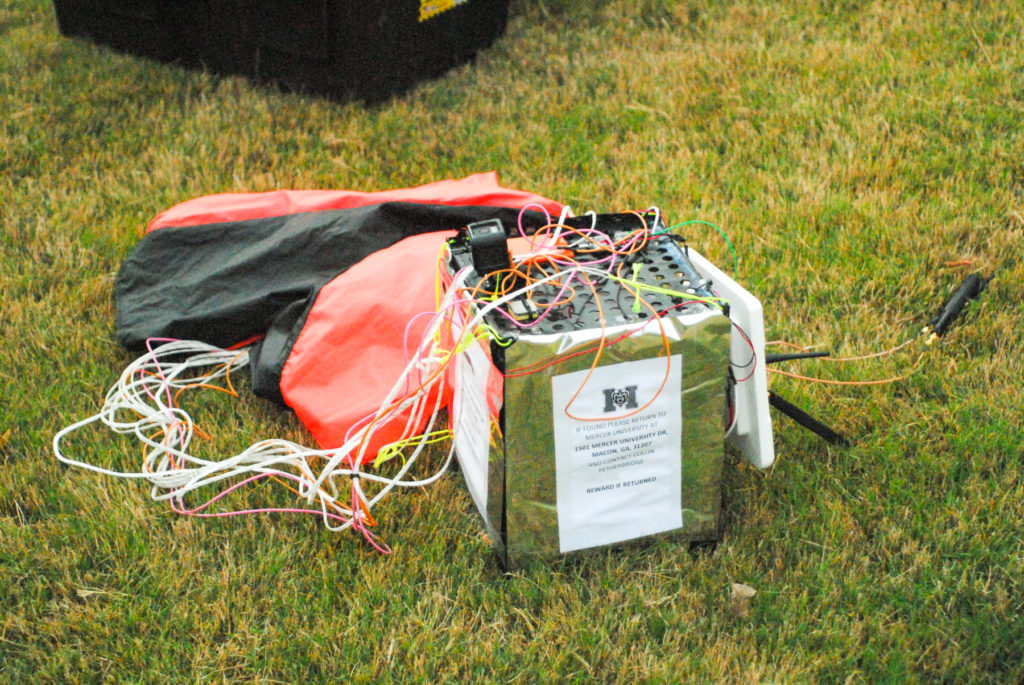
Standing in a grassy area on the Macon campus, about a dozen members of the Mercer Robotics Club prepared to launch a massive balloon deep into the Earth’s atmosphere.
The hydrogen-filled balloon — known as a high-altitude research platform, or HARP — can travel to an altitude of 100,000 feet, allowing students to study their experiments in a near space environment.
The April 15 launch, which coincided with BEAR Day, tested a new set of tracking systems on the HARP.
“This launch was good because it showed us that the tracking system is functional,” said Colin Petherbridge, a junior double-majoring in electrical and computer engineering. “Now, it’s just a matter of tweaking a lot of the systems to make it more accurate.”
The experiment was the latest in a series of collaborations between Mercer University’s School of Engineering and NASA, bringing Mercer one step closer to its long-term goal of developing an academic Center for High-Altitude Payload Delivery.
The center would serve as a launch hub for experiments from K-12 schools, colleges and universities, and the community. In addition, it would offer outreach activities for schools and organizations, said Dr. Anthony Choi, professor of electrical and computer engineering and director of Machine Intelligence and Robotics.
“We would actually give them specifications, and as long as they design within that form factor, we would just plug into our system and then be able to tie into our payload (the box containing the experiments) and launch it, and then they should be able to connect to our website to be able to get real live data of their experiments,” he said.
While NASA offers the opportunity for groups to send experiments into space through its CubeSat Launch Initiative, it’s very expensive, costing about $10,000 per pound to put an experiment into orbit. The Mercer center would provide a low-cost way for people to access a similar environment in near space, Dr. Choi said.
“What we’re going to do is we’re going to be able to bring space close enough that students can really touch the experiment that goes into space,” he said. “I think it gives a difference sense of involvement and understanding and excitement for students in K-12 and even at upper levels.”
But before that happens, the team must refine the HARP’s components, including the tracking system.
In previous launches, the HARP relied on iridium GPS satellite tracking, but the iridium modem, a restricted device, was costly and took a long time to obtain, Dr. Choi said. The latest launch relied on the radio-based Automatic Packet Reporting System for tracking.
“This new tracking system that students are designing is such a critical component,” he said.
Preparing for launch
Months of work, which at its peak involved almost 30 students, went into preparing for the April 15 HARP launch. Students from freshmen to seniors, and even graduate students, worked weekly in the Machine Intelligence and Robotics Laboratory on the project, Petherbridge said.
“We had two freshmen partner together and help write the emergency cut down mechanism,” he said. “Everyone gets to participate. The mechanicals (mechanical engineering majors) redesigned the base station this year. …

“We’ve designed all the communication systems, all the tracking on our own to lower the costs greatly as well as hopefully increase the accuracy.”
Because the HARP travels into the stratosphere, the balloon must meet Federal Aviation Administration requirements, including density and weight restrictions, and notify the FAA of its plans to launch, said Jonathan Mittleider, a junior majoring in mechanical engineering.
A few weeks before the launch, the team orders the hydrogen that will be used to inflate the balloon, he said.
The students run multiple simulations that allow them to think about the balloon’s flight path and where it’s projected to land, Dr. Choi said.
And they monitor the weather to avoid high winds and rain. Even though the balloon is water resistant, it’s not waterproof, he said.
Everything, from the emergency cut down mechanism to the tracking system, is tested and double checked. Every system is checked a third time on launch day before filling the balloon with hydrogen, Petherbridge said.
“Once the balloon is full, everyone gives all the project’s leaders — the lead of the chase, the lead on the roof with the base station and then the lead with the balloon — the OK,” said Alex Mitchell, a senior majoring in computer engineering. “And we release the balloon, and it begins to float off.”
The balloon will stay up a maximum of two hours before reaching 100,000 feet and popping. If the balloon doesn’t pop after two hours, the emergency cut down mechanism will cut the balloon from the payload, so it drops, he said.
The balloon launched April 15 popped sooner than expected at about 40,000 feet, and the payload landed in a tree near Swainsboro.
“Even though we could not recover the physical device, Colin was still able to extract all the data from this launch,” Mitchell said. “We’re hoping in a couple of months a storm will come through and just knock the physical device down.”
A key part of the project has been being able to communicate with experiments in the payload throughout the launch. The students hope to add live video to the balloon, as they did in a 2017 NASA collaboration to capture footage of a solar eclipse, Petherbridge said.
Dr. Choi said the students have done an amazing job of leading, teaching and inspiring their peers.
“These students are really the life and blood of this project that they lead,” he said. “I could disappear, and this project would still keep going. That’s how good these students are.”









